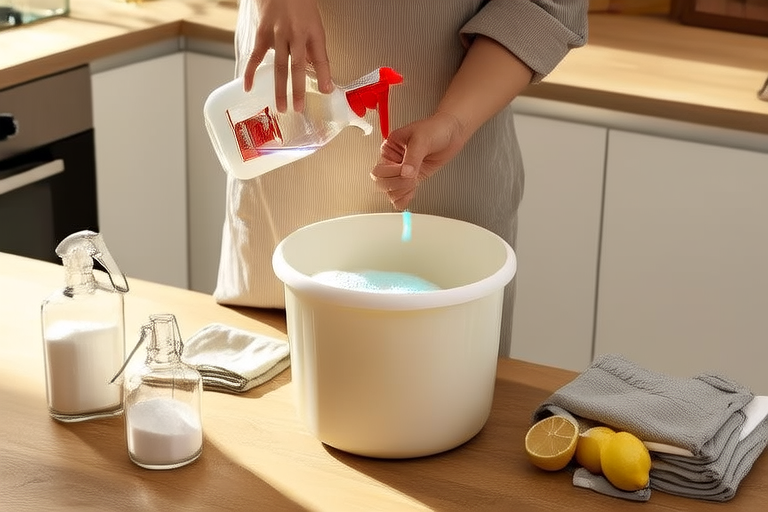How to Create an Eco-Friendly Cleaning Routine Without Breaking the Bank
Introduction: The Importance of Eco-Friendly Cleaning
In today’s world, where environmental consciousness is more important than ever, adopting eco-friendly practices in our daily routines can make a significant difference. One area that often gets overlooked is cleaning. Traditional cleaning products are often laden with harsh chemicals that not only harm the environment but also pose health risks to you and your family. By switching to eco-friendly cleaning solutions, you can protect the planet while saving money. This article will guide you through creating an effective, budget-friendly eco-friendly cleaning routine.
Understanding Eco-Friendly Cleaning Products
What Constitutes an Eco-Friendly Product?
An eco-friendly cleaning product is one that is biodegradable, non-toxic, and free from harmful chemicals like phosphates, chlorine, and artificial fragrances. These products are designed to break down naturally without leaving a lasting impact on the environment. They are typically made from plant-based ingredients and are packaged in recyclable materials, reducing waste.
Why Choose Eco-Friendly Over Conventional?
Eco-friendly cleaning products are gentler on both the environment and your health. They do not release volatile organic compounds (VOCs) into the air, which can cause respiratory issues. Additionally, they are often less expensive in the long run because many can be made at home using simple, affordable ingredients.
DIY Eco-Friendly Cleaning Solutions
Basic Ingredients for Homemade Cleaners
Creating your own cleaning solutions is one of the most cost-effective ways to go green. You’ll need just a few basic ingredients:
- White vinegar: A powerful disinfectant and degreaser.
- Baking soda: Great for scrubbing and deodorizing.
- Castile soap: Versatile and biodegradable.
- Essential oils: For natural scents and additional cleaning power.
Step-by-Step Guide to Making Common Cleaners
All-Purpose Cleaner
Ingredients:
- 1 cup white vinegar
- 1 cup water
- 10 drops of essential oil (optional)
Instructions:
- Mix the vinegar and water in a spray bottle.
- Add the essential oil for fragrance.
- Shake well before each use.
Glass Cleaner
Ingredients:
- 2 cups water
- 1/4 cup rubbing alcohol
- 1/4 cup white vinegar
- 1 tablespoon cornstarch
Instructions:
- Combine all ingredients in a spray bottle.
- Shake well.
- Spray on glass surfaces and wipe clean with a microfiber cloth.
Bathroom Cleaner
Ingredients:
- 1/2 cup baking soda
- 1/4 cup liquid castile soap
- 2 tablespoons white vinegar
Instructions:
- Mix the ingredients in a bowl to form a paste.
- Apply the paste to surfaces and scrub.
- Rinse thoroughly with water.
Choosing Eco-Friendly Commercial Products
Identifying Green Certifications
When purchasing commercial products, look for certifications such as the Environmental Protection Agency’s (EPA) Safer Choice label or the Leaping Bunny logo, which indicates cruelty-free testing. These certifications ensure that the products meet rigorous standards for environmental safety.
Budget-Friendly Brands
Several brands offer eco-friendly products at competitive prices:
- Seventh Generation: Known for their commitment to sustainability and affordability.
- Method: Offers a range of products with minimal packaging and natural ingredients.
- Ecover: Specializes in biodegradable and phosphate-free products.
Implementing Your Eco-Friendly Cleaning Routine
Creating a Cleaning Schedule
A well-organized cleaning schedule ensures that your home stays clean without overusing products. Here’s a suggested weekly schedule:
- Daily: Quick dusting, wiping counters, and emptying trash.
- Weekly: Vacuuming, mopping floors, and bathroom cleaning.
- Monthly: Deep cleaning carpets, windows, and upholstery.
Tips for Efficient Cleaning
- Use reusable cloths instead of paper towels.
- Opt for mop heads with washable covers.
- Store cleaning supplies in a dedicated, easily accessible spot.
Conclusion: Taking Action for a Greener Home
By integrating eco-friendly cleaning practices into your routine, you not only contribute to a healthier planet but also enjoy a safer living environment. Remember, small changes can lead to big impacts. Start by trying out some DIY cleaners and gradually incorporate more sustainable products.
Action Steps:
- Begin with one homemade cleaner this week.
- Review your current cleaning products and replace them with eco-friendly alternatives.
- Share your experiences and tips with friends and family to inspire others.
Embracing an eco-friendly cleaning routine is a win-win situation—better for the environment and better for your wallet.
